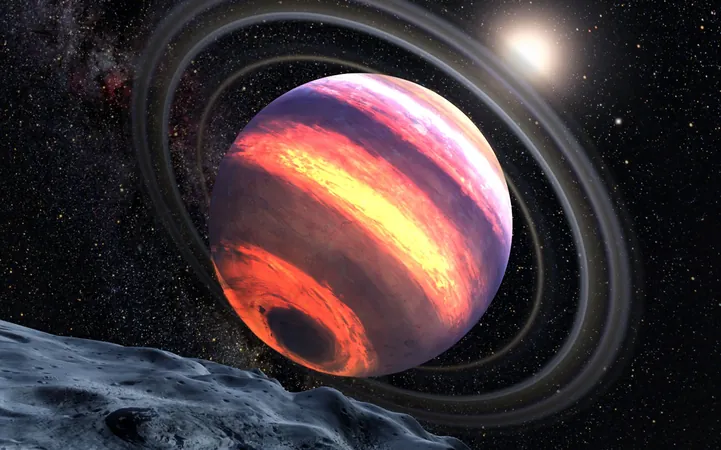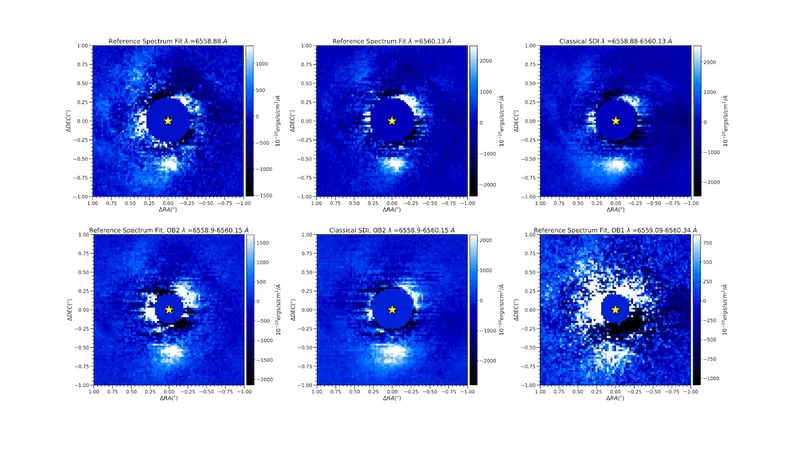
Astounding Discovery: Building Blocks of Life Identified in Planet-Forming Cloud Around Baby Star
2025-08-06
Author: Daniel
In a groundbreaking revelation, astronomers have uncovered essential organic molecules that could pave the way for life, nestled within the planet-forming disc of a young star named V883 Orionis.
Using the powerful Atacama Large Millimeter/submillimeter Array (ALMA) in Chile, a team from the Max Planck Institute for Astronomy identified no fewer than 17 complex organic molecules, including ethylene glycol and glycolonitrile—both previously theorized but never seen in such an environment.
A Star Bursting with Potential
V883 Orionis is no ordinary baby star; it’s in the midst of a vigorous growth phase, drawing in gas and releasing a torrent of energy. This cosmic outburst temporarily heats its surrounding dust and ice disc, liberating complex organic molecules trapped within frozen grains, making them detectable by astronomers.
According to Kamber Schwarz, a scientist at MPIA, "These complex molecules, including ethylene glycol and glycolonitrile, radiate at radio frequencies, making ALMA the perfect tool for their detection." Among the detected molecules are vital precursors to amino acids and nucleobases, key components of life.
Life-Friendly Chemistry Emerges Early
The research provides profound insights into the origins of life, challenging the old notion that the dramatic transitions from protostar to fully developed star would obliterate fragile organic compounds. The team’s findings support a more optimistic scenario where complex molecules may not only survive but also thrive during early star formation.
Abubakar Fadul from MPIA states, "Our discovery suggests a continuous chemical enrichment linking interstellar clouds to fully evolved planetary systems, meaning the seeds of life may be more prevalent across the universe than we previously thought."
The Mechanism Behind Molecule Release
The formation of these life-signaling molecules begins on a cosmic scale when tiny dust grains act as laboratories, where simple atoms undergo chemical evolution. The young star’s energy bursts heat the icy regions of its disc, similar to how comets vaporize and release organic compounds as they approach the Sun.
This process allows complex molecules to escape their icy traps and become detectable to scientists eagerly searching for the substances that may spark life.
An Ongoing Quest for Life's Chemistry
While the discoveries surrounding V883 Orionis are thrilling, the MPIA team acknowledges that many mysteries remain unsolved. "Higher resolution data will be critical to verifying our findings and potentially unveiling even more complex molecules that we haven’t yet identified," Schwarz adds.
This ongoing quest for understanding the chemistry of life is far from over, with implications suggesting that life-supporting molecules might not just be a rare occurrence but rather common in our universe.
The Universe: A Favorable Place for Life?
The discovery of these complex organic molecules supports a more intriguing idea: the universe could be chemically inclined to produce life from the very beginning. If such molecules are indeed widespread in planet-forming areas, then life-supporting chemistry might be a universal phenomenon, not just an isolated incident.
Although this research does not confirm the existence of life itself, it implies that the essential building blocks are out there, waiting to be activated by the warmth of newly formed stars.
This remarkable research was documented in the renowned journal, The Astrophysical Journal Letters.

 Brasil (PT)
Brasil (PT)
 Canada (EN)
Canada (EN)
 Chile (ES)
Chile (ES)
 Česko (CS)
Česko (CS)
 대한민국 (KO)
대한민국 (KO)
 España (ES)
España (ES)
 France (FR)
France (FR)
 Hong Kong (EN)
Hong Kong (EN)
 Italia (IT)
Italia (IT)
 日本 (JA)
日本 (JA)
 Magyarország (HU)
Magyarország (HU)
 Norge (NO)
Norge (NO)
 Polska (PL)
Polska (PL)
 Schweiz (DE)
Schweiz (DE)
 Singapore (EN)
Singapore (EN)
 Sverige (SV)
Sverige (SV)
 Suomi (FI)
Suomi (FI)
 Türkiye (TR)
Türkiye (TR)
 الإمارات العربية المتحدة (AR)
الإمارات العربية المتحدة (AR)